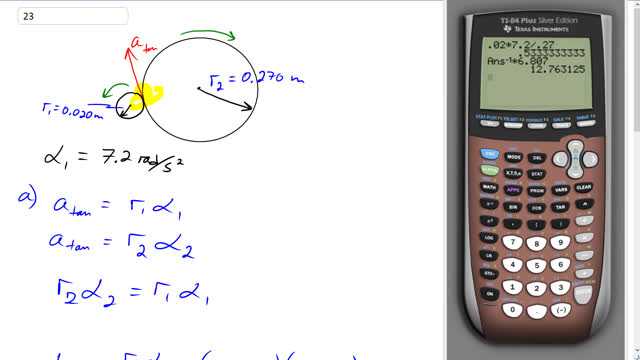
A small rubber wheel is used to drive a large pottery wheel. The two wheels are mounted so that their circular edges touch. The small wheel has a radius of 2.0 cm and accelerates at the rate of , and it is in contact with the pottery wheel (radius 27.0 cm) without slipping. Calculate
- the angular acceleration of the pottery wheel, and
- the time it takes the pottery wheel to reach its required speed of 65 rpm.

In order to watch this solution you need to have a subscription.
This is Giancoli Answers with Mr. Dychko. When the small wheel rotates one way, the large pottery wheel rotates the other way because the two are in contact with each other at this point and because that point of contact is not slipping that means the linear velocities of both wheels at this particular point is the same and also the tangental component of the acceleration's of these points therefore will also be the same. And we can express tangental acceleration in terms of the small wheel number 1 as the radius 1 times the angular acceleration α 1 or we can express that same tangental acceleration in terms of the large pottery wheel— its radius we'll call r 2—times its angular acceleration α 2. And since these two things both equal a tangent—the same quantity— that means they are both equal to each other as shown here and we'll solve for α 2, the angular acceleration of the pottery wheel by dividing both sides by r 2 and we get α 2 is r 1α 1 over r 2. So that's 0.020 meters radius of the small wheel times its angular acceleration 7.2 radians per second squared divided by the radius of the pottery wheel 0.270 meters and that gives about 0.53 radians per second squared. The amount of time it takes for the pottery wheel to get up to its required speed of 65 rpm— we'll use this formula to get that— the final angular velocity equals the initial angular velocity, which is 0, times by the angular acceleration times time and we'll express the final angular velocity in radians per second by multiplying 65 revolutions per minute by 1 minute for every 60 seconds and then times by 2π radians for every revolution. And so we get this: 6.807 radians per second—final angular velocity— divided by 0.5333 radians per second squared and that gives about 13 seconds. If you are curious about my calculator technique here when I calculated the first answer, 0.5333, I then hit... the reciprocal button, x to the negative 1, that automatically takes the answer to the power of negative 1 which is the same as dividing so we are multiplying this 6.807 by the reciprocal of the answer which is the same as going 6.807 divided by 0.5333; a little bit less button pushing by doing this.